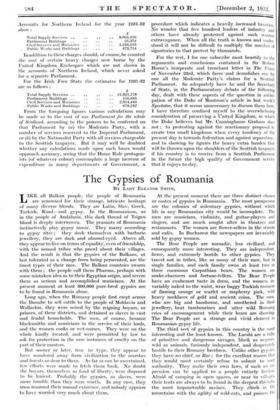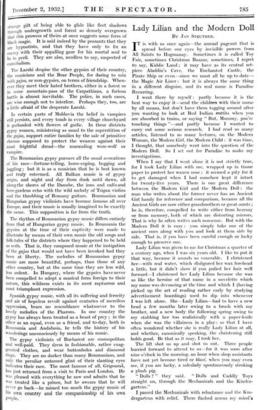The Gypsies of Roumania
BY LADY ELEANOR SMITH,
AIRE all Balkan people, the people of Roumania are renowned for their strange, intricate heritage of many diverse bloods. They are Latin, Slav, Greek, Turkish, Kurd—and gypsy. In the Roumanians, as in the people of Andalusia, this dark thread of Tsigan blood is deeply interwoven. The peasants of Roumania instinctively play gypsy music. They marry according to gypsy rites ; they deck themselves with barbaric jewellery, they are dark and almond-eyed. Above all, they appear to live on terms of equality, even of friendship, with the nomad tribes who prowl about their villages. And the result is that the gypsies of the Balkans, at last tolerated as a change from being persecuted, are the finest types of their race. The Balkan countries swarm with them ; the people call them Pharons, perhaps with some mistaken idea as to their Egyptian origin, and revere them as serious and accomplished musicians. At the Present moment at least 800,000 pure-bred gypsies are to be found in Roumania alone.
Long ago, when the Romany people first crept across the Danube to sell cattle to the people of Moldavia and Wallachia, they were seized by the reigning boyars, or Princes, of these districts, and detained as slaves in vast and feudal households. The men, of course, became blacksmiths and musicians in the service of their lords, and the women cooks or wet-nurses. They were on the whole kindly treated, and were permitted by law to ask for protection in the rare instances of cruelty on the part of their masters.
But sooner or later, true to type, they appear to have wandered away from civilization to the marshes and forests so dear to them. As far as can be ascertained, few efforts were made to fetch them back. No doubt the boyars, themselves so fond of liberty, were disposed to be lenient. Probably the gypsies, as slaves, were more trouble than they were worth. In any case, they soon resumed their nomad existence, and nobody appears to have worried very much about them. At the present moment there are three distinct classes or castes of gypsies in Roumania. The most prosperous are the colonies of sedentary gypsies, without which life in any Roumanian city would be incomplete. The men are musicians, violinists, and guitar-players and singers, and are much sought after in theatre and restaurants. The women are flower-sellers in the streets and cafés. In Bucharest the newspapers are invariably sold by gypsy women.
The Bear People are nomadic, less civilized, and consequently more interesting. They are independent, fierce, and extremely hostile to other gypsies. They travel not in tribes, like so many of their race, but in single families, and each family owns at least two or three enormous Carpathian bears. The women are snake-charmers and fortune-tellers. The Bear People have an exuberant taste in dress, and the women, in- variably naked to the waist, wear baggy Turkish trousers of flaming orange or scarlet or raspberry pink, with heavy necklaces of gold and ancient coins. The men, who are big and handsome, and smothered in flash jewellery, beat tambourines and utter wild Romany cries of encouragement while their bears are dancing. The Bear People are a strange and vivid element in Roumanian gypsy life.
The third sect of gypsies in this country is the most interesting and the least known. The Laeshi are a tribe of primitive and dangerous savages, black as negroes, wild as animals, furiously independent, and desperately hostile to their Romany brethren. Unlike other gypsies, they have no chief, or Bar ; for the excellent reason that they would most certainly refuse to submit to suet authority. They make their own laws, if such an es, pression can be applied to a people entirely lawless. Afraid of camping in open spaces, or near to villages, their tents are always to be found in the deepest thickets, the most impenetrable ravines-. They climb in the mountains with the agility of wild-eats, and possess the strange gift of being able to glide like fleet shadows through undergrowth and forest so densely overgrown that this prowess of theirs at once suggests some form of black magic. It is said indeed by the peasants that they are hypnotists, and that they have only to fix an enemy with their appalling gaze for his mortal soul to be in peril. They are also, needless to say, suspected of cannibalism.
The Laeshi despise the other gypsies of their country, the musicians and the Bear -People, for daring to mix with gajos, or non-gypsies, on terms of friendship. When- ever they meet their hated brothers, either in a forest or in some mountain-pass of the Carpathians, a furious battle is almost inevitable. The police, in such cases, are wise enough not to interfere. Perhaps they, too, are a little afraid of the desperate Laeshi.
In certain parts of Moldavia the belief in vampires still persists, and every tomb in every village churchyard is garlanded with flowers of garlic. In these districts gypsy women, ministering as usual to the superstition of the gajos, support entire families by the sale of primitive charms supposed to protect the wearers against their most frightful dread—the marauding were-wolf or vampire.
The Roumanian gypsy pursues all the usual avocations of his race—fortune-telling, horse-coping, begging and juggling ; but it is as a musician that he is best known and truly esteemed. All Balkan music is of gypsy origin, and night and day from dusk until dawn, all along the shores of the Danube, the inns and cafes and beer-gardens echo with the wild melody of Tsigan violins and the throbbing of Romany guitars. Roumanian and Hungarian gypsy violinists have become famous all over Europe, and their music is usually imagined to be exactly the same. This supposition is far from the truth.
The rhythm of Roumanian gypsy music differs entirely from that of Hungarian gypsy music. In Roumania the gypsies at the time of their captivity were made to illustrate by means of their own music the old songs and folk-tales of the districts where they happened to be held as serfs. That is, they composed music at the instigation of the gajos that would not have been invoked had they been at liberty. The melodies of Roumanian gypsy music are more beautiful, perhaps, than those of any other country, but at the same time they are less wild, less ardent. In Hungary, where the gypsies have never been compelled to adopt a musical form foreign to their nature, this wildness exists in its most rapturous and most triumphant expression.
Spanish gypsy music, with all its suffering and ferocity and air of hopeless revolt against centuries of merciless oppression, bears no resemblance whatsoever to the lovely melodies of the Pharons. In one country the gypsy has always been treated as a beast of prey ; in the other as an equal, even as a friend, and to-day, both in Roumania and Andalusia, he tells the history of his wanderings unconsciously by means of his music.
The gypsy violinists of Bucharest are cosmopolitan and well-paid. They dress in fashionable, rather exag- gerated clothes, and wear buttonholes and diamond rings. They are no darker than many ROumanians, and Only the peculiar untamed glint of their slanting eyes indicates their race. The most famous of all, Grigoural, has just' returned from a visit to Paris and London. He Was pleased with everything he saw and admits that he was treated like a prince, but he swears that he will never go back—he missed too much the gypsy music of his own country and the companionship of his own People.











































 Previous page
Previous page